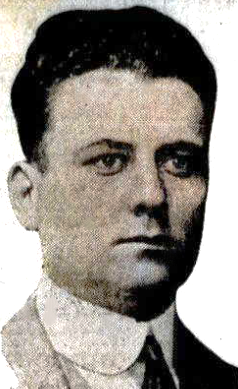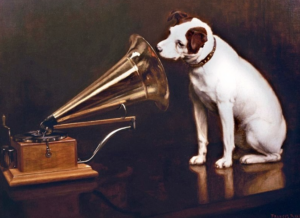Title: Army Corporal, World War I
Birthdate: September 2, 1893
Death Date: March 5, 1920
Plot Location: Section E, Range 10, Lot 3, east line

The Floyd family came to Philadelphia in 1905 from Shamokin, a mill and mining town in east central Pennsylvania. George was the only child of Elizabeth and her husband William, who found work as an electrician in John Wanamaker’s department store.
George’s first job was in a stock broker’s office as a clerk but before he turned 20 he became a salesman for the Victor Talking Machine Company. T he Camden-based manufacturer was the leading producer of records and phonographs, popularized by this iconic photo and the “His Master’s Voice” trademark.
he Camden-based manufacturer was the leading producer of records and phonographs, popularized by this iconic photo and the “His Master’s Voice” trademark.
He was single, a member of the Elks, living with his parents, and attending Calvin Presbyterian Church with them as he had always done. At age 18 George enlisted in the Pennsylvania National Guard, where he was captain of his company’s basketball team during their championship season of 1913-1914. His full-time job selling “Victrola” record players was put on hold in 1916 when his part-time status with the Guard was changed.
President Woodrow Wilson called up National Guard units from all 48 states after the Mexican revolutionary leader Pancho Villa attacked a New Mexico border town. Villa’s intent was to draw the United States into the Mexican Revolution, but the Mexican government refused Wilson’s offer to help. George and over 140,000 others were called to Texas but stayed there as part of “The Mexican Expedition” between June, 1916 and February, 1917. They spent most of their time in intensive field training, which was worthwhile because America entered World War I in April, 1917.
George’s unit didn’t return until May, so while he was there he registered for the draft with the clerk’s office in Milam County, Texas. They returned home soon afterward, but George became Private Floyd in the United States Army that September. Back to Texas he went, as part of Headquarters Company, 19th Field Artillery, ordered to Camp MacArthur, which had just been built outside Waco, Texas.
A hospital was onsite, which was fortunate for George, who had a serious (but unidentified) accident on post in the spring of 1918. His obituary says, “His life was saved by an operation, from the effects of which he had never fully recovered.” He was given an honorable SCD (service-connected disability) discharge on May 18, being unable to do any heavy work.
What he did for the next 15 months is unclear but in the fall of 1919 he entered what was then called the Wharton School of Finance and Commerce of the University of Pennsylvania. The photo above was taken during his first semester there.
His mother must have been so proud to have her only child alive, at home, and in school, overcoming the tragedy that cut short his tour of duty. Unfortunately, he wasn’t able to finish his freshman year.
Around the first of March, George was taken to Lankenau Hospital where he was diagnosed with lethargic encephalitis, an inflammation of the brain most likely caused by a virus. Sometimes called sleeping sickness, patients may lay motionless and speechless while suffering other symptoms like a high fever, headache, upper body pain, or double vision.
History reveals there was an epidemic of this disease between 1915-1926. It affected a million or more people, causing a half-million deaths. It didn’t capture as much attention, however,  since it was overshadowed by the 1918-20 influenza pandemic known then as the “Spanish Flu.”
since it was overshadowed by the 1918-20 influenza pandemic known then as the “Spanish Flu.”
With his fiancée and parents at his bedside, George passed away on March 5. He had been a member of the Vesper Boat Club and many of them attended the funeral at his parents’ home, at 1314 South Wilton Street.
He had also joined the American Legion, which received its national charter from Congress the previous September. Members of Post 7 handled all the details to create a dignified military funeral. Three soldiers and three sailors, in dress uniform, served as pallbearers, Legion members comprised the military escort, and “Taps” was played in the final moments of interment at Mount Moriah.

Support the Friends of Mount Moriah
Help us in our mission to restore and maintain the beautiful Mount Moriah Cemetery by donating to our cause or volunteering at one of our clean-up events.

